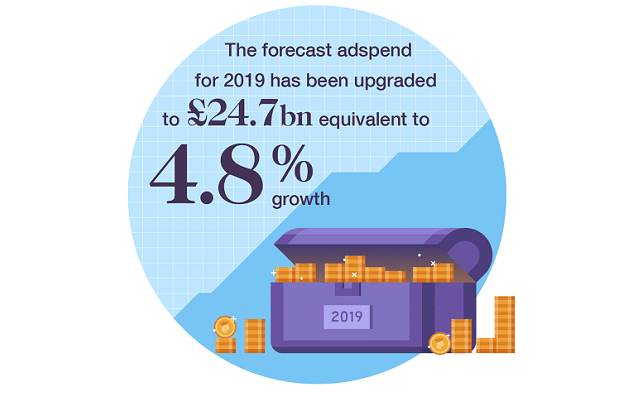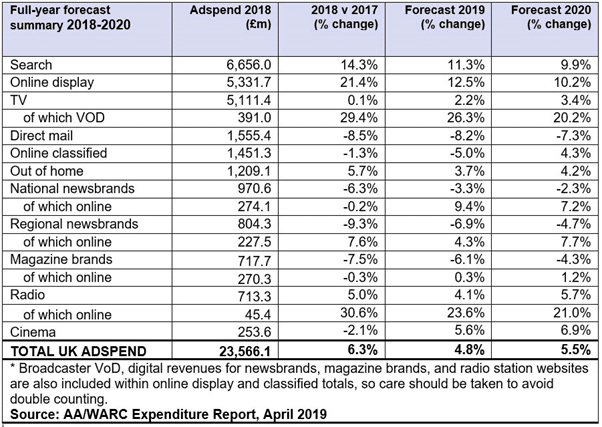
According to the latest data from the Ad Association and Warc, this growth was largely driven by rising investment in paid search and online display formats, particularly social media and online video.
Despite most traditional media being stagnant or in decline, the UK’s ad market expanded at its strongest rate since 2015 last year, with adspend rising 6.3% year-on-year.
The key bullet points from the report show:
- UK adspend rose 6.3% year-on-year to reach £23.6bn in 2018 – the ninth consecutive year of market growth
- UK adspend rose 5.7% year-on-year to reach £6.5bn in Q4 2018 – the 22nd consecutive quarter of market growth
- Both the 2018 annual and fourth quarter totals were the highest on record
- Over H2 2018, UK adspend rose 5.6% year-on-year to reach £12.1bn – a new high
- The forecast for 2019 has been upgraded to £24.7bn, equivalent to 4.8% growth
- The UK’s ad market is expected to grow a further 5.5% in 2020
“These online components account for just over half of UK advertising spend today, and both are almost entirely data-driven, enabling advertisers to pair their messaging with internet users based on their digital footprint,” said James McDonald, managing editor at WARC.
“These tools are also accessible, enabling a long-tail of SMEs to invest, and this has transformed the DNA of advertising in recent years.”
The final quarter of 2018 recorded expenditure growth of 5.7% over Q4 2017, with adspend reaching £6.5bn. This includes adspend during the Christmas trading period and marked the 22nd consecutive quarter of market growth.
Overall, adspend is forecast to grow 4.8% this year, with a further rise of 5.5%, projected for 2020. This would push investment to over £26bn, completing more than a decade of continuous expansion for the UK advertising industry.
Within the forecast, traditional linear TV is forecast to grow 3.4% by next year, however television VoD is forecast to grow 20.2%.
Similarly, radio is forecast to grow by 5.7% over the same time, while investment in online radio formats are set to rise by 21%, the highest forecast growth recorded in the report.
This is in contrast to direct mail, which is forecast to decline by -7.3% by 2020 and printed media, which remains in decline. However, online news and magazine brands have still been forecast growth – 7.2% and 1.2%, respectively.

Commenting on the results, Stephen Woodford, chief executive, AA, said the figures demonstrate “the strength and resilience” of the UK advertising industry during a time of political and economic uncertainty in the UK.
“They are a testament to the world-class capabilities of the third of a million people working in advertising and marketing services across the UK,” Woodford said. “With every pound spent on advertising generating six pounds of GDP, a strong advertising industry is a key pillar of a strong economy.
“With further growth predicted for both 2019 and 2020, UK advertising looks set to deliver over a decade of continuous growth. Like all UK industries, we hope to see a positive resolution of the Brexit situation, with business-friendly data, immigration and trade outcomes that could further boost this forecast growth”.
Overall market growth is being driven by increasing spend on search (up 14.3%) and online display advertising (up 21.4%), with further, but milder, growth predicted for 2019 and 2020.
The positive story for online ad formats was reflected across a number of media. Notably high growth was recorded for online radio ad formats, with a year-on-year rise in 2018 of 30.6%.
Ad investment in broadcaster video-on-demand rose 29.4% to reach £391m, while regional online newsbrands recorded growth of 7.6%.
“Yet another consecutive quarter of growth and a record level of investment really highlights the importance businesses are placing on advertising,” said Josh Krichefski, CEO at media agency MediaCom UK.
“Even in the face of uncertainty, brands are increasingly turning to advertising for long term and short term growth.”
Industry analysis:
“Good time to explore marketing partnerships”
Florian Gramshammer, Managing Director EMEA, Impact, said: “The latest AA/WARC report reveals the continuing strength across the advertising industry. It’s promising to see expected growth of 5.5% in 2020, proving that the industry has regained trust and confidence in advertising. It is important to not rest on our laurels however and the industry must continue to reinforce the messaging and actions of trust and transparency, if want to see this continue. The growth in overall budgets also provides a good opportunity for marketers to explore other avenues, particularly with partnerships. We expect to see marketers streamlining their partnership programmes across multi-platforms to deliver increased ROI. By delivering strong performance and value for marketers, we will warrant the increased spend from marketers into this sector in 2020.”
Combating “feed fatigue”
Damon Reeve, CEO, The Ozone Project, said: “There is much to be encouraged by in the latest AA/WARC forecasts, particularly for digital news brands. To finally see growth after a number of flat years (despite a growing digital readership) is cause for optimism. This trend is a reflection on the state of the current programmatic advertising market, one that is currently plagued by persistent issues of brand safety and transparency. There is a growing preference by brands to know where their media spend is going, and they want to invest in reaching audiences in quality contextual and trusted environments.
“Digital strategies are evolving to focus on customer and marketing value metrics, rather than the unit price of an impression. This means that cheap open market inventory will give way to an investment in audiences in quality environments where readers are more engaged. These engagement levels of readers in quality environments stands in contrast to the same users often suffering “feed fatigue” when consuming user generated content.
“Context really does matter, and as regulation and browser developments make it more difficult to build persistent digital audiences profiles, there will be an increased reliance placed on contextual understanding. And no one is better at understanding context than news brands. The latest AA/WARC forecast shows that brands are starting to agree.”
“Creative, localised content is key in a cluttered advertising landscape”
Grant Munro, Senior VP of Shutterstock Custom, said: “With a significant amount of ad spend being driven by online display formats, the demand for quality branded content is growing. Creative, localised content is key in grabbing the attention of audiences in a cluttered advertising landscape. Although forecasts predict continued spend, marketers still have budgets that must be stuck to and creating a constant flow of branded content for campaigns puts pressure on budgets and takes time.
“Marketers must find affordable ways to create consistent, high quality, content tailored to their target audiences.”
